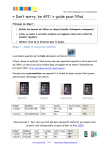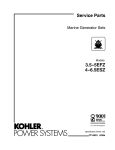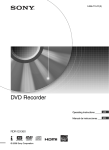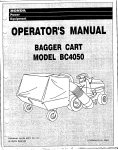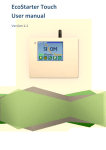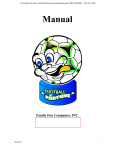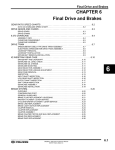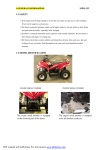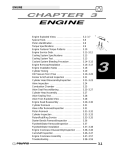Download 3 - Art Start
Transcript
SERVICE MANUAL Honda HONDA CONDENSED SPECIFICATIONS Models HT3813, HT4213 Engine Make Model Number of cylinders Bore Stroke Displacement Power Rating Slow Idle High Speed (No-Load) Crankcase Capacity Transaxle Capacity Coolant Capacity Honda GX360 2 58 mm (2.28 in.) 68 mm (2.68 in.) 359 cc (21.9 cu. in.) 9.7 kW (13 hp.) 1300 rpm 3300 rpm 1.4 L* (1.5 qt.) 2.9 L (3.1 qt.) 1.35 L (1.4 qt.) *If installing new filter, check oil level after running engine for a few minutes. NOTE: Honda special tools may be required for some procedures and are indicated in the text. Read the text completely before attempting procedure. FRONT AXLE AND STEERING SYSTEM MAINTENANCE Lubricate the steering spindles annually or after 100 hours of operation. Inject multipurpose grease into the grease fittings at the axle’s outer ends. Clean the grease fittings before and after lubrication. FRONT WHEELS AND BEARINGS Each front wheel is supported by two sealed ball bearings not requiring periodic lubrication. Replace the bearings if they are loose or do not spin smoothly. Tighten the bearing retaining nut to 55-65 N·m (40-47 ft.-lb.). Secure the nut with a cotter pin. TIE ROD AND TOE-IN Fig. HN1-1—Exploded view of front axle assembly. 1. Spindle (left) 2. Bushing 3. Axle main member 4. Tie rod 5. Washer 6. Bolt 7. Steering lever 8. Drag link 9. Bolt 10. Snap ring 11. Spindle (right) The tie rod (4—Fig. HN1-1) is equipped with threaded ends at each end. Replace the tie rod if the ends are damaged. The recommended front wheel toe-in is 6-14 mm (0.24-0.55 in.). Measure the 209 Honda YARD & GARDEN TRACTORS Punch marks Punch marks Spindle Fig. HN1-3—Align punch marks on steering lever and spindle during assembly. Fig. HN1-2—Measure distance “A” and “B” at front and rear of front wheels to determine front wheel toe-in. distance (A—Fig. HN1-2) between the front of the front wheels at hub height and the distance (B) between the rear of the front wheels. The front distance (A) should be smaller than the rear distance (B). To adjust toe-in, loosen the locknut at each tie rod end and rotate the tie rod. NOTE: Left tie rod end and nut have left-hand threads. STEERING SPINDLES REMOVAL AND INSTALLATION To remove the steering spindle, raise and support the front of the tractor. Remove the front wheel. Disconnect tie rod end from spindle. To remove the left spindle (1—Fig. HN1-1), remove the clamp bolt (6) and detach the steering arm (7) from the spindle. Slide spindle out of the axle. When installing the steering lever, align the punch mark on the spindle end with the punch mark on the steering arm (Fig. HN1-3). To remove the right spindle (11—Fig. HN1-1), detach the snap ring (10) and slide the spindle out of the axle. AXLE MAIN MEMBER REMOVAL AND INSTALLATION The complete front axle assembly may be removed as a unit. To remove the axle main member (3—Fig. HN1-1), raise and support the front of the tractor. Disconnect the drag link’s (8) outer end. Support the axle main member and remove the axle retaining bolt (9). Lower the axle main member from the mainframe pivot point and roll the axle out from under the tractor. When installing the axle main member, tighten the axle retaining bolt to 45-55 N·m (33-40 ft.-lb.). 210 STEERING GEAR OVERHAUL To remove the steering shaft and gear assembly, remove the cover (1—Fig. HN1-4) and nut (2). Remove the steering wheel (3) and flat washer (4). Disconnect the drag link end and steering arm (15). Remove the cap screws retaining the steering plate (8). Remove the three cap screws retaining the steering gear holder (17). Remove the nut (11) and pull the steering shaft (6) out of the tractor. Remove the gear (9) and washer (10). Remove the steering gear (14) and washers (13 and 16). Replace the bushings (5, 7 and 12) as required. Reverse the removal procedure for reassembly. Make certain the front wheels are straight ahead, the larger opening in the steering wheel is toward the top and the steering gears are meshed in the center of the gear (14) during reassembly. Tighten the three bolts retaining the steering gear holder (17) to 23-30 N·m (17-22 ft.-lb.) and nuts (2 and 11) to 45-54 N·m (33-40 ft.-lb.). SAFETY INTERLOCK SYSTEM The tractor is equipped with switches and relays preventing inadvertent starting of the tractor engine or operation if the operator leaves the tractor seat. The tractor engine should not start if the following occurs (engage parking brake): • Operator in the tractor seat, shift lever in NEUTRAL and the PTO clutch lever in the ON position. • Operator in the tractor seat, PTO clutch lever in the OFF position and the shift lever in a position other than NEUTRAL. • Operator not in the seat when starting the engine. The seat switch should kill the engine if the operator is not in the seat or leaves the seat when the PTO clutch is engaged or the tractor is in gear. Fig. HN1-4—Exploded view of steering gear assembly. 1. 2. 3. 4. 5. 6. 7. 8. 9. Cover Nut Steering wheel Washer Bushing Steering shaft Bushing Steering plate Gear 10. 11. 12. 13. 14. 15. 16. 17. Washer Nut Bushing Washer Sector gear Steering arm Washer Steering gear holder Refer to the wiring schematics at end of this section. ENGINE MAINTENANCE The engine is equipped with a dry air filter that should be cleaned and inspected after every 50 hours of operation. SERVICE MANUAL Fig. HN1-5—To bleed cooling system, open air bleed screw (S) and proceed as described in text. Remove the foam and paper air filter elements from the air filter housing. Wash the foam element in a mild detergent and water solution. Rinse in clean water and allow to air dry. After the foam element is dry, soak it in clean engine oil. Squeeze out excess oil. Paper element may be cleaned by directing low pressure compressed air stream from inside the filter toward the outside. Replace the paper element if it cannot be cleaned satisfactorily, or if it is damaged. The engine oil level should be checked prior to operating engine. Check the oil level with the oil cap not screwed in, but just touching the opening’s threads. Oil should be changed after the first 20 hours of engine operation and after every 100 hours thereafter. Change the oil filter after every 300 hours of operation or after two years. Use oil meeting the latest API service classification. Use SAE 10W-30 or 10W-40 oil; use SAE 10W-40 if the temperature is above 90°F (32°C). Crankcase capacity is 1.4 liters (1.5 qt.). REMOVAL AND INSTALLATION Raise the hood and disconnect the battery cables. Disconnect the headlight wiring connector and remove bolt from the ground lead. Remove the hood hinge bolts and remove the hood. Drain the coolant. Detach the radiator hoses and remove the radiator. Loosen the PTO belt tension knob and remove the mower drive belt. Detach the engine ground cable from the front frame crossmember. Disconnect the throttle cable. Disconnect the fuel hoses. Disconnect the wiring from the starting motor, charge coil and ignition coil. Honda Remove regulator/rectifier bracket assembly from the engine. Separate the wiring from the engine. Remove the cooling fan. Remove the PTO clutch as described in the PTO CLUTCH section. Detach the PTO cable from the brackets. Remove the engine mounting bolts and nuts. Lift the engine and move it forward to separate the engine from the drive shaft and remove it from the tractor. Reverse the removal procedure to install engine. Tighten front engine retaining nuts to 35-40 N·m (26-29 ft.-lb.). stat, are covered in the appropriate Honda engine section at rear of this manual. MAINTENANCE Maintain the coolant level between the reservoir tank’s MIN and MAX marks. The recommended coolant is a 50:50 mixture of clean water and permanent antifreeze. Periodically clean debris from the radiator screen. Periodically inspect coolant hoses between the radiator and engine water pump. Replace damaged hoses. OVERHAUL Engine make and model are listed in specifications table at the beginning of this section. Refer to the appropriate Honda engine section in this manual for service information on the engine and associated accessories. FUEL SYSTEM Refer to ENGINE and ELECTRICAL SYSTEM sections for fuel system related components not covered here. FUEL FILTER MAINTENANCE A fuel filter is located in the fuel line between the fuel tank and the fuel pump. The fuel filter is visible through a hole in the rear hitch plate. Inspect the fuel filter annually or after every 100 hours of operation. Replace the filter if it is dirty or damaged. FUEL PUMP The fuel pump is located on a bracket below the fuel tank. Testing Before testing the fuel pump be sure the fuel filter and fuel line are in good condition and the fuel flow to the pump is unimpeded. Connect a suitable pressure gauge to the fuel pump output port. Turn the ignition switch ON, but do not start the engine. Fuel pump pressure should be 6.9-14.2 kPa (1.0-2.0 psi). Direct a hose from pump output port into a container. Turn the ignition switch ON, but do not start the engine. Fuel pump volume should be at least 350 cc (11.8 oz.) during one minute of operation. COOLING SYSTEM Cooling components on the engine, such as the water pump and thermo- WARNING: Coolant in the system is pressurized. Remove the pressure cap only when engine is cold. Change the coolant at least every two years. Flush the cooling system at least every three years. Coolant system capacity is approximately 1.35 liters (1.4 qt.). CHANGE COOLANT Remove the engine’s pressure cap (C–Fig. HN1-5). Drain coolant by opening radiator drain valve. WARNING: Coolant in the radiator is pressurized. Remove pressure cap only when the engine is cold. Empty the reservoir tank. Close the radiator drain valve. Open the air bleed screw (S—Fig. HN1-5). Refill with a 50:50 mixture of clean water and permanent antifreeze. Pour coolant into the fill hole until air-free coolant runs out of bleed screw hole, then reinstall the bleed screw. Position the pressure cap on the filler neck, but do not tighten the cap. Run the engine until the upper radiator hose becomes warm. Stop the engine and add coolant through the filler neck as needed. Install and tighten the pressure cap. Fill the reservoir tank with coolant to proper level. Run the engine, while monitoring the engine temperature to be sure the engine does not overheat. Allow the engine to cool and recheck the coolant level. HOSE ROUTING The left radiator hose connects to the thermostat housing. The right radiator hose connects to a spigot on the right side of the cylinder block. Bypass hose attaches to a spigot at the right rear of 211 Honda YARD & GARDEN TRACTORS Shift lever Clutch arm Adjusting nuts Shift gear plate 0.5-1.0 mm (0.02-0.04 in.) Fig. HN1-7—Turn adjusting nuts at end of clutch cable to adjust cable free play. Refer to text. Fig. HN1-6—Exploded view of clutch linkage. Adjust clutch rod (2) length by turning nuts (1) at rod end. 1. 2. 3. 4. Adjusting nuts Clutch rod Clutch cable Damper arm 5. 6. 7. 8. Damper Adjustment bolt Damper spring Clutch arm the cylinder block and connects to the thermostat housing. CLUTCH The clutch is a disc that is actuated by linkage connected to the shift lever and clutch/brake pedal. The clutch is disengaged when the shift lever is moved to another slot or the brake is applied. A hydraulic cylinder (damper) attached to the clutch linkage regulates clutch engagement speed. ADJUSTMENT Be sure the clutch is not worn excessively before attempting clutch adjustment. See INSPECTION section. With the shift lever in the second gear slot, measure the lever free play between the side of the lever and the closed end of the slot. The permissible range for lever free play is 3-12 mm (0.12-0.47 in.); desired free play is 7-8 mm (0.27-0.31 in.). Adjust the shift lever free play by altering length of clutch rod (2—Fig. HN1-6). Turn the adjusting nut (1) clockwise to increase free play or counterclockwise to decrease free play. NOTE: Shift lever free play affects clutch engagement time. 212 9. 10. 11. 12. Spring Change arm bracket Bushing (2) Washer (2) 13. 14. 15. 16. Bushing (2) Clutch arm shaft Stopper arm Spring Less free play will slow the clutch engagement time; more free play will make the clutch engage faster. Start the engine and shift the transmission into first gear. Note the clutch engagement time; it should be less than one second. If necessary, adjust shift lever free play to obtain desired clutch engagement action. If proper clutch engagement cannot be obtained by adjusting the shift lever free play within the permissible range, the clutch may be faulty. Clutch cable free play should be 0.5-1.0 mm (0.02-0.04 in.). To adjust, remove the seat and rear fenders. Shift the transmission into second gear. Push the clutch arm towards the shift lever and hold it there. Adjust the nuts (Fig. HN1-7) at the rear end of the clutch cable to obtain the desired cable free play. Hold the shift lever all the way toward the seat. Adjust position of the stopper bolt (1—Fig. HN1-8) so the end of the clutch rod lightly contacts the head of the stopper bolt. INSPECTION To check the clutch’s condition, place the gearshift lever in the second speed slot. Raise the seat and remove inspection hole cover. The indicator mark on Fig. HN1-8—Exploded view of drive clutch assembly. 1. 2. 3. 4. 5. 6. 7. 8. 9. 10. 11. 12. 13. 14. 15. 16. 17. 18. 19. 20. 21. 22. 23. 24. 25. 26. Stop bolt Clutch plate Bolt Dust seal plate Clutch rod Bearing locknut Ramp Ball retainer Rear clutch housing Nut Lifter plate Clutch disc Pressure plate Special washer Bearing Bearing Collar Washer Cap screw Spring Clutch setting spring Clutch cover Nut Damper hub Damper Drive shaft SERVICE MANUAL Aligning marks Honda Red mark Spring end Upper lock nut 10 ± 1 mm (0.4 ± 0.004 in.) Index mark Threaded stud Clevis pin Lower lock nut Fig. HN1-9—Measure the distance “D” between lifter plate and pressure plate to determine clutch disc thickness. Fig. HN1-11—Align end of clutch spring with threaded stud prior to assembly. Rod end Upper nut Stop plate Fig. HN1-10—Exploded view of springloaded clutch pack with special spring compressor tool 07960-75000A. 1. 2. 3. 9. 11. 12. 13. 20. 22. Nut Washer Special tool Special tool Lifter plate Clutch disc Pressure plate Spring Clutch cover the clutch lever should be between the two notches on the clutch housing (Fig. HN1-9). If the indicator mark is past the red notch on the clutch housing, clutch disc must be replaced. Measure the distance (D) between the lifter plate and pressure plate. The permissible range is 4.5-6.1 mm (0.18-0.24 in.). If the measurement is less than 4.5 mm (0.18 in.), clutch disc is excessively worn. If distance is more than 6.1 mm (0.24 in.), clutch is out of adjustment. OVERHAUL Remove the seat and rear fenders. Remove the drive shaft. Disconnect all clutch linkage. Remove three screws retaining the damper hub (24—Fig. HN1-8) and remove the hub. Remove the cap screw (19) and washer (18). Remove the three nuts (10) and slide the clutch assembly off the transaxle input shaft. Use a spanner wrench or special tool 07916-3710100 to remove the left-hand thread bearing locknut (6). Use special Jam nut Fig. HN1-12—Adjust upper nut so clutch rod end height “A” is between 37-39 mm (1.45-1.53 in.). spring compressor tool 07960-750000A or other suitable tool to compress the spring (20) in clutch pack (Fig. HN1-10). With the tool compressing the clutch pack, remove the three nuts (23—Fig. HN1-8). Slowly unscrew the spring compressor tool and disassemble the clutch pack. The thickness of the clutch facing on the disc (12—Fig. HN1-8) should be 5.9-6.1 mm (0.232-0.240 in.). Replace the clutch disc if worn to a thickness of 4.5 mm (0.177 in.) or less. The spring (20) free length should be 58.2 mm (2.29 in.). Replace the spring if the free length is less than 56.2 mm (2.21 in.). Replace the clutch damper rubber (25) if damaged. When reassembling the clutch, refer to Fig. HN1-8. Align the spring end with one of the three threaded studs on the pressure plate (Fig. HN1-11). Install the clutch disc (12—Fig. HN1-8) with the splined hub’s long side toward the lifter plate (11). Tighten the nuts (23 and 10—Fig. HN1-8) to 10-13 N·m (88-115 in.-lb.). Tighten the screw (19) to 24-30 N·m (18-22 ft.-lb.). Make certain the dust plate (4) is mounted on the clutch plate (2) and that the clutch plate studs are through the dust plate holes. Lower adjusting bolt Flat pin Fig. HN1-13—Adjust locknut on upper end of damper until there is 10 mm (0.4 in.) clearance between bottom of nut and the clevis pin. If removed, reinstall the clutch rod end (Fig. HN1-12) so the top of rod end is 37-39 mm (1.46-1.53 in.) above the stop plate. Adjust the upper nut to obtain the desired height, and tighten the jam nut. To determine if the clutch damper is functioning properly, remove the damper and suspend a 3.5 kg (7.7 lb.) weight from the bolt end of damper. After fully compressing the damper, measure the time required for the weight to fully extend the damper. A normally functioning damper should extend in 3.4-4.3 seconds on Models HT3813K0 or 2.7-3.4 seconds on Models HT3813K1 and HT4213. Allowable limit is 3.2-4.5 seconds on Models HT3813K0 or 2.4-3.8 seconds on Models HT3813K1 and HT4213. Before installing the damper, adjust the bolt position at the damper’s lower end. The end of the adjusting bolt should be 25-27 mm (0.98-1.06 in.) from the upper end of slot in the damper bracket. Tighten jam nut to hold the bolt’s position. Install the damper. Move the shift lever to NEUTRAL. Thread the lower locknut (Fig. HN1-13) onto the damper as far as it will go toward the damper body. Compress, then release the damper. Be sure the lower adjusting bolt is seated against the flat pin in the damper bracket (Fig. FN1-13). Turn the damper upper locknut so it is 9-11 mm (0.35-0.43 in.) above the clevis pin (Fig. HN1-13). Hold the upper nut so it cannot turn, then rotate the lower nut so the clevis pin is forced up against the upper nut. BRAKE The tractor is equipped with a drum brake located in the transaxle case. The brake drum is mounted on the transaxle countershaft. 213 Honda YARD & GARDEN TRACTORS The brake may be actuated either with the clutch/brake pedal or the parking brake lever. The clutch/brake pedal actuates both the clutch and brake. When the parking brake lever is engaged, an indicator lamp lights. If the parking brake is engaged when the transmission is shifted into gear, a warning buzzer sounds. No clearance ADJUSTMENT Depressing the brake pedal disengages the drive clutch and applies the brake. Brake pedal rod must be adjusted so there is no clearance (Fig. HN1-14) between the end of operating rod and the front end of the brake pedal slot when the brake pedal is released. To adjust, loosen the jam nuts (2) and turn the brake rod (4) to remove any clearance. When new brake shoes are installed, turn the cam plate rod adjusting nut (6—Fig. HN1-14) so there is a slight clearance between the rod end and the bottom end of the slot in the cam arm plate (5) when the brake pedal is released. To check for proper parking brake cable adjustment, pull the parking brake lever up until the ratchet locks. The end of the parking brake cable should be aligned with the punch mark on the spring sleeve (Fig. HN1-15). To adjust, loosen the cable adjuster locknut and turn the adjuster as required. OVERHAUL To check brake shoe wear, depress the brake pedal and note position of the brake wear indicator (N—Fig. HN1-16) located near the brake assembly on the transaxle. If the indicator is near the wear limit point (P), replace the brake shoes. To remove the brake shoes, remove the seat, rear fender and wire protector. Raise the tractor’s right side so the transaxle oil will not flow out. Remove the screw (1—Fig. HN1-17), washer (2) and brake drum (3). Remove the brake spring (4) and shoes (5). Brake lining thickness wear limit is 2.35 mm (0.093 in.). If the brake cam (6) is removed, reinstall the cam in the brake arm (11) so the punch marks on the cam and arm are aligned. Adjust the brake linkage as previously described. SHIFT CONTROL LINKAGE ADJUSTMENT The operator gearshift lever and transaxle gear selector arm must be 214 Fig. HN1-14—Adjust brake rod (4) so there is no clearance between the end of the brake rod and front end of brake pedal slot. 1. Brake pedal 2. Jam nuts 3. Clutch cable 4. Brake rod 5. Cam plate 6. Adjusting nut synchronized for proper gear selection. Loosen jam nuts on the rod and rotate the rod end to adjust the rod length. NO T E : R e a r j a m n u t h a s left-hand threads. 7. Cam arm 8. Brake drum 9. Parking brake lever Lever Brake cam arm Brake drum Ratchet Lock nut Spring sleeve Adjuster Punch mark Parking brake cable The punch marks (P–Fig. HN1-18) on the shift lever shaft (12) and shifter arm (16) must be aligned. Move the shift lever to NEUTRAL. Check the punch mark on the transaxle shifter shaft (19) aligns with the index mark cast in the top of the transaxle case. Adjust the shift rod (17) length so the shift lever (6) is centered in the N-notch of the shifter console. Move the shift lever to each gear position on the console and check that the proper gear is engaged in transaxle. Tighten the shift rod jam nuts. REMOVAL AND INSTALLATION To remove the shift linkage, remove the shift lever knob (1—Fig. HN1-18), seat and rear fenders. Remove the pivot bolt (11) and withdraw the shift lever (6). Remove the snap rings (2 and 3) and thrust washer (4). Pull the clutch roller (7) and bearing (5) off the shift lever. Detach the shift rod (17) from the shifter arm (16). Remove the clamp bolt (18) and withdraw the shift lever shaft (12) from the shifter arm (16). Inspect all parts for wear or damage and replace when necessary. When installing the shift linkage, align the punch marks on the shift lever shaft (12) and shifter arm (16). Adj us t t h e l i n k a g e a s p r e v i o u s l y described. Fig. HN1-15—The end of the parking brake cable must align with the punch mark on the spring sleeve when the parking brake is engaged. Refer to text. Fig. HN1-16—If brake wear indicator (N) is near wear limit point (P), replace brake shoes. TRANSAXLE The tractor is equipped with a five-speed transaxle. The transaxle also provides a reverse gear. A drum brake is attached to the transaxle mainshaft and is located in a compartment on the right side of the transaxle. Refer to previous sections for service information on brake and clutch assemblies. LUBRICATION The transaxle oil level should be checked annually or after every 100 hours of operation. The transaxle oil should be level with the bottom edge of the fill cap opening located at the rear SERVICE MANUAL Honda Fig. HN1-17—Exploded view of brake assembly. 1. 2. 3. 4. Screw Washer Brake drum Brake spring 5. 6. 7. 8. Brake shoes Cam Stud Backing plate 9. Parking brake rod 10. Brake rod 11. Brake arm 12. Bolt 13. Seal Fig. HN1-18—Exploded view of shift linkage. 1. 2. 3. 4. 5. 6. 7. 8. 9. 10. 11. 12. 13. 14. 15. 16. 17. 18. 19. of the transaxle. Be sure the machine is on a level surface when checking the oil level. Oil capacity is 2.9 liters (3.1 qt.). Recommended oil is SAE 10W-40 engine oil. REMOVAL AND INSTALLATION Raise and support the rear of the tractor. Remove the left and right wheels. Remove drive shaft and drive clutch. Disconnect shift rod from transaxle shift lever. Disconnect all interfering electrical wires. Remove the fuel pump. Disconnect brake rod from the brake lever. Knob Snap ring Snap ring Thrust washer Ball bearing Shift lever Clutch roller Snap ring Sleeve Spring Bolt Change lever shaft Thrust washer Bushings Bracket Shifter arm Shift rod Clamp bolt Transaxle shifter shaft Support the transaxle and remove transaxle mounting bolts. Lower the transaxle assembly out of the frame and pull the transaxle from the tractor. Reinstall by reversing the removal procedure. Tighten transaxle retaining screws to 24-30 N·m (18-22 ft.-lb.). Refill transaxle with oil as described in the LUBRICATION paragraph. Adjust brake, clutch and shift linkage as previously described. OVERHAUL Remove the drain screw and drain the oil from the transaxle. Remove the brake assembly. Unscrew and remove the input shaft bearing housing (3—Fig. HN1-19). Break or bend back the staked area of nut (6). Using Honda tool 07916-7500000, unscrew the nut (6) and remove the input shaft (9). The old nut should be discarded. If bearing (8) must be removed, use Honda tool 07916-7500000 to unscrew the nut (7). Remove seal (1) and drive or press out the bearing (5). Unscrew and separate the transaxle case halves (11 and 19). Remove the left axle shaft (14), bearings and seals as needed from the left housing (19). Remove the countershaft gear (1—Fig. HN1-20) and shaft (2), differential assembly (23) and mainshaft and sliding gear shaft as an assembly (4) from the right hou Remove the setscrew (9) from the shift arm (10) and pull the shift shaft (16) out of the housing. Remove bearings and seals from the housing as needed. Separate the gears from the mainshaft (6—Fig. HN1-21) and sliding gear shaft (24). Be careful not to lose the detent balls (21) and springs (20) when separating the gear selector (23) and sliding gear shaft (24). NOTE: Ring gear (3—Fig. HN1-22) retaining screws have left-hand threads. To disassemble the differential, remove the bearings (2—Fig. HN1-22) from the differential case (4). Unscrew the ring gear screws (left-hand threads) and separate the ring gear (3) from the case. Drive out the spring pin (7) and remove the pinion shaft (10), side gears (6) and pinion gears (9) and thrust washers (5 and 8). Inspect all parts for damage and replace when necessary. Install new oil seals and gaskets when assembling. When reassembling transaxle, note the following: If input shaft (9—Fig. HN1-19), input shaft bearing, bevel gear, main shaft (6—Fig. HN1-21), shims or transaxle cases were replaced, refer to the following section for the shimming procedure. Washers (11—Fig. HN1-21) are 2 mm (0.080 in.) thick and the washer (19) is 1 mm (0.039 in.) thick. Install a Belleville washer (7) so the cup side is toward the gear (6). Install countershaft drive gear (8) so the extended hub is toward end of sliding gear shaft (24). Install the countershaft driven gear (1—Fig. HN1-20) so the extended hub is facing away from the countershaft gear teeth. Tighten the ring gear (3—Fig. HN1-22) retaining screws (left-hand threads) to 45-55 N·m (33-40 ft.-lb.). 215 Honda YARD & GARDEN TRACTORS Tighten the inner pinion gear nut (7—Fig. HN1-19) to 70-80 N·m (52-58 ft.-lb.) and outer nut (6) to 90-110 N·m (67-80 ft.-lb.). During final assembly, stake the outer nut (6) into the slot in the transaxle case. Tighten the input shaft housing (3—Fig. HN1-19) cap screws to 20-24 N·m (15-17 ft.-lb.). Tighten the transaxle case cap screws to 8-14 N·m (6-10 Tighten the axle shaft-to-rear wheel nut to 550-65 N·m (40-47 ft.-lb.). Tighten the neutral switch to 16-20 N·m (12-15 ft.-lb.). Gear Shimming Procedure Input shaft gear and bevel gear contact pattern and backlash must be checked if the input shaft (9—Fig. HN1-19), input shaft bearing, bevel gear, gear shaft (6—Fig. HN1-21), shims or transaxle cases have been replaced or changed. Coat the input bevel gear (9—Fig. HN1-19) with Prussian Blue or other suitable compound. Make a trial assembly by installing the input shaft assembly and the mainshaft and bevel gear assembly in the transaxle cases using the original pinion shaft shim (10—Fig. HN1-19) and mainshaft shim (1—Fig. HN1-21). Assemble the case halves. Rotate the input shaft in the normal direction, then remove the shaft and check the contact pattern on the input gear teeth. Contact area should be centered on the tooth surface. If the contact area is toward the outer edge of tooth, install a thinner shim (10—Fig. HN1-19). If contact area is toward base of tooth, install a thicker shim (10). After correctly adjusting the bevel gear teeth contact, reassemble the transaxle. Check the bevel gear backlash. Attach a hose clamp or other device to the mainshaft to provide a reading point. Position a dial indicator on the mainshaft (Fig. HN1-23). Prevent the input shaft from turning using the clutch or other device. Gently rotate the mainshaft back and forth while observing the dial indicator reading. Backlash should be 0.016-0.026 mm (0.0006-0.0010 in.). If backlash is insufficient, decrease the thickness of the mainshaft shim (1—Fig. HN21). If backlash is excessive, increase the shim’s thickness. PTO BELT ADJUSTMENT Adjust belt tension by turning the tension knob at front of tractor. Belt tension is correct when the mark on the 216 Fig. HN1-19—Exploded view of transaxle pinion shaft assembly and left axle shaft. 1. 2. 3. 4. 5. 6. 7. 8. Seal Bracket Bearing housing Gasket Bearing Outer nut Inner nut Bearing 9. Pinion shaft 10. Shim 11. Transaxle case half 12. Bearing 13. Washer 14. Axle shaft, left 15. 16. 17. 18. 19. Bearing Washer Bearing Gasket Transaxle case half 20. 21. 22. 23. 24. 25. 26. Oil seal Oil seal Fill plug O-ring Dowel Bearing Bearing Fig. HN1-20—Exploded view of transaxle. Also refer to Fig. HN1-19 and HN1-21. 1. Countershaft driven gear 2. Countershaft 3. Washer 4. Mainshaft and change shaft assembly 5. Washer 6. Bearing 7. Bearing 8. 9. 10. 11. 12. 13. 14. 15. Bearing Setscrew Shifter arm Transaxle case, right Oil seal Oil seal Oil seal Neutral switch 16. Shifter shaft 17. Oil seal 18. Bearing 19. Washer (25 mm) 20. Axle shaft, right 21. Washer (20 mm) 22. Bearing SERVICE MANUAL Honda Dial indicator Clutch plate Friction disc Clutch side plate Clearances Lock nut Mainshaft shim Fig. HN1-23—Use a dial indicator to measure bevel gear backlash. Refer to text. Fig. HN1-21—Exploded view of transaxle mainshaft and change shaft. 1. 2. 3. 4. 5. 6. 7. 8. 9. 10. 11. 12. 13. 14. 15. 16. 17. 18. 19. 20. 21. 22. 23. 24. Shim th Main 5 gear (37T) th Main 4 gear (28T) rd Main 3 gear (21T) Main 2nd gear (16T) Mainshaft & bevel pinion gear Belleville washer Countershaft drive gear Thrust washer Change 5th gear (32T) Spacer (2 mm) Change 4th gear (41T) rd Change 3 gear (48T) nd Change 2 gear (53T) Change 1st gear (56T) Neutral positioner Reverse chain Reverse gear Spacer (1 mm) Detent spring (3) Detent ball (3) Spring pin (2) Key holder Change shaft Tension arm Fig. HN1-25—Use a feeler gauge to measure the PTO clutch plate clearances “A” and “B”. Refer to text. PTO CLUTCH A cable-actuated disc clutch is attached to the end of the engine crankshaft. A switch prevents the engine starting if the PTO operating lever is in the engaged position. ADJUSTMENT Alignment mark Tension indicator Fig. HN1-24—Turn belt tension adjusting knob to adjust PTO belt tension. Refer to text. idler bracket aligns with the mark on the tension bracket (Fig. HN1-24). REMOVAL AND INSTALLATION To remove the PTO belt, lower the mower deck. Loosen the belt tension knob. Raise the idler pulley and remove the belt from pulleys and mower deck. Fig. HN1-22—Exploded view of differential assembly. 1. Washer 2. Bearing 3. Ring gear 4. Differential case 5. Thrust washer (2) 6. 7. 8. 9. 10. Side gear (2) Spring pin Shim washer Pinion gear (2) Pinion shaft Adjusting bolt Belt tension adjusting knob Open the hood and detach the belt guide. Open the upper radiator shroud and remove the belt from the top by routing it past the radiator. Install the belt by reversing the removal procedure. Position the belt guide 3-6 mm (0.12-0.18 in.) from pulley. Adjust belt tension as described in previous section. To adjust the PTO clutch, open the hood and move the PTO clutch lever to the OFF position. Using a feeler gauge, measure the clearance (A—Fig. HN1-25) between the clutch plate and friction disc and clearance (B) between the friction disc and the clutch side plate. Add the two measured clearances together. Loosen the locknut and turn the adjusting bolt as necessary so the total (A plus B) clearance is 0.6 mm (0.02 in.). The PTO operating lever free play should be 1-3 mm (0.04-0.1 in.) measured at the lever’s outer end. To adjust free play, raise the hood and rotate adjusting nuts at the end of the clutch cable housing. Tighten the nuts and recheck free plaOVERHAUL Before removing the PTO clutch, disconnect the negative battery cable. Remove the hood, radiator, fan and mower drive belt. Disconnect the PTO clutch cable (4—Fig. HN1-26). Detach the clutch return spring (2—Fig. HN1-26). Unscrew the retaining screw (24), and remove the fan hub (22) and clutch assembly from the en- 217 Honda YARD & GARDEN TRACTORS gine crankshaft. Remove the nuts from the special bolts (3) and remove the brake disc (5), ball retainer (9) and ball control plate (7). Unscrew the nuts and bolts securing the clutch components. Separate the drive pulley (18) and clutch components (12-17). The standard brake disc (5) lining thickness is 7.0 mm (0.28 in.). Replace the brake disc if the lining is less than 5.0 mm (0.20 in.). Standard friction disc (13) lining thickness is 6.0 mm (0.24 in.). Replace the brake disc if the lining is less than 3.0 mm (0.12 in.). The brake and friction discs must be replaced as a set. Do not replace one without replacing the other. To determine the correct shim thickness (11–Fig. HN1-26), assemble the components (12-20). Place the assembly on a bench with the pulley (18) down. Push down on the friction disc hub so it contacts the pulley bearing (Fig. HN1-27). Measure the height (H) of the friction disc hub above the back face of the clutch bracket. Install shim thickness based on hub height above the bracket face as specified in the following table: Hub Height Shim Thickness Over 6.00 mm . . . . . . . . . . . . . . . . . 1.10 mm (0.236 in.) (0.043 in.) 5.90-6.00 mm . . . . . . . . . . . . . . . . . 1.20 mm (0.232-0.236 in.) (0.047 in.) 5.80-5.90 mm . . . . . . . . . . . . . . . . . 1.30 mm (0.228-0.232 in.) (0.051 in.) 5.70-5.80 mm . . . . . . . . . . . . . . . . . 1.40 mm (0.224-0.228 in.) (0.055 in.) 5.60-5.70 mm . . . . . . . . . . . . . . . . . 1.50 mm (0.220-0.224 in.) (0.059 in.) Under 5.60 mm . . . . . . . . . . . . . . . . 1.60 mm (0.220 in.) (0.062 in.) After assembly, measure the clearance between the side plate (Fig. HN1-25) and friction disc, then measure the clearance between the friction disc and clutch plate. Add the clearances together. Total clearance should be 0.6 mm (0.024 in.). Rotate the adjusting screw to obtain the specified clearance. Adjust the PTO control cable as described in the previous section. With the engine stopped, move the PTO control lever to the engaged position. Measure the gap between the brake pad on the brake disc (5—Fig. HN1-26) and the back face of the bracket (12). The gap should be 1.5-2.3 mm (0.060-0.090 in.). If the gap is not correct, repeat adjustments. ELECTRICAL SYSTEM Engine related electrical components, such as the starter, are covered in the appropriate Honda engine section at the rear of this manual. 218 Fig. HN1-26—Exploded view of PTO clutch. 1. 2. 3. 4. 5. 6. 7. 8. 9. Spring bracket Spring Special bolt PTO cable Brake disc Spacer Ball control plate Adjusting bolt Ball retainer 10. 11. 12. 13. 14. 15. 16. 17. REGULATOR/RECTIFIER Key Shim Clutch cover Side plate Friction disc Clutch plate Spring seat Spring 18. 19. 20. 21. 22. 23. 24. 25. Pulley Bearing Snap ring Key Fan hub Washer Screw Fan Friction disc hub The regulator/rectifier is attached to a bracket on the left side of the engine and can be identified by the fins on the body (Fig. HN1-28). To test the unit, connect an ohmmeter to the terminals of the regulator/rectifier (Fig. HN1-29) as indicated in the chart in Fig. HN1-30. Replace the regulator/rectifier if the specified values are not obtained. DIODE The tractor is equipped with a six-terminal diode in the fuel control circuit. The diode is located below the PTO control lever. Pulley bearing Fig. HN1-27—Measure clutch disc hub height (H) to determine adjusting shim thickness. Refer to text. SERVICE MANUAL Honda Fig. HN1-28—Drawing showing wiring harness routing. 1. 2. 3. 4. 5. 6. 7. T5 T4 8. 9. 10. 11. 12. 13. 14. Headlight switch Fuse box Main wire harness Ground cable Regulator/rectifier Thermoswitch Starter motor (+) T1 (-) 1 1 T2 T3 Fig. HN1-29—Connect ohmmeter to regulator/rectifier terminals and refer to regulator/rectifier test procedure in text. Refer to test table (Fig. HN1-30) for test values. -Tester lead T1 +Tester lead T1 T2 T3 T4 T5 A A A B A A C A C T2 C T3 C A T4 D E E T5 B A A Fig. HN1-31—Connect ohmmeter to diode terminals and refer to diode test procedure in text. Refer to test table (Fig. HN1-32) for test values. 1. Green/Yellow I 2. Green/White 3. Green/Yellow II Buzzer relay 4. Green 5. Green/Red 6. White/Black Charge coil Rear wire harness Fuel pump Neutral switch Parking brake switch Seat switch Combination switch 2 3 4 5 6 1-200 ¥ ¥ ¥ ¥ ¥ ¥ ¥ ¥ 1-200 ¥ ¥ ¥ ¥ 2 ¥ 3 ¥ ¥ 4 ¥ ¥ ¥ 5 ¥ ¥ ¥ ¥ 6 ¥ ¥ ¥ ¥ 1-200 ¥ Fig. HN1-32—Diode test table. Refer to Fig. HN1-31 for terminal identification. Main fuse (20A) Fuel pump relay Fuse (5A) Fuse box D A Fig. HN1-30—Regulator/rectifier test table. Refer to Fig. HN1-28 for terminal identification. A. Infinity B. 0.2k-5k ohms C. 0.5k-20k ohms Starter relay D. 1k-50k ohms E. 0.5k-10k ohms To test the diode, disconnect wire connector from diode and use an ohmmeter set on R×1. Refer to Fig. HN1-31. In three separate tests, connect the positive ohmmeter lead to terminal 2 and the negative lead to terminal 1, the positive ohmmeter lead to terminal 4 and the negative lead to terminal 3, the positive ohmmeter lead to terminal 6 and the negative lead to terminal 5. In the foregoing tests, the ohmmeter should read 1-200 ohms (Fig. HN1-32). Connect the ohmmeter to all other terminal combinations. Ohmmeter Control relay Rear wire harness Relay bracket Main wire harness Fig. HN1-33—Electrical system relays are mounted on the relay bracket located next to the battery. should read infinity except in the three tests where 1-200 ohms should be found. amp fuses are also used to protect some circuits. The fuses are located on a bracket adjacent to the battery. FUSES WIRING DIAGRAM A 20 amp main fuse (Fig HN1-33) protects the electrical system. Three 5 The wiring schematic for the tractor is shown in Fig. HN1-34. 219 Honda YARD & GARDEN TRACTORS Diagram Key Fuses G/R B/Y B/Y B/Y Connectors Buzzer relay Ground Frame ground G/L G/B G G/Y Fuel pump relay Control relay B/Y G/R B/R B B/Y W/B B/W B/W B/Y G/L R/W B/Y Starter relay Connection No connection W/B G/R G G/Y G/W G/Y Diode PTO clutch switch G/Y B Parking brake switch G/B B Neutral switch B/Y B Fuel pump G/R B Seat switch R/W R/W Headlight switch R/W B G/W Headlight G/W Thermo switch G/L G/Y Parking brake lamp G/L G/W Overheat alert lamp Color Code G/L G/Y Buzzer Charging coil Ignition coil Battery W B/W B/Y B/R B B B B B/W Starter motor + Fig. HN1-34—Wiring schematic. Regulator/ rectifier - B Gr Gr B/Y W B/R Main fuse Spark plugs 220 W/B G/B Off On Start Combination switch B W R G L Y Br Gr Dg B/W B/R B/L B/Y W/B R/B R/W R/G G/B G/W G/R G/L G/Y G/O L/B Y/B Y/G Black White Red Green Blue Yellow Brown Gray Dark green Black/White Black/Red Black/Blue Black/Yellow White/Black Red/Black Red/White Red/Green Green/Black Green/White Green/Red Green/Blue Green/Yellow Green/Orange Blue/Black Yellow/Black Yellow/Green












